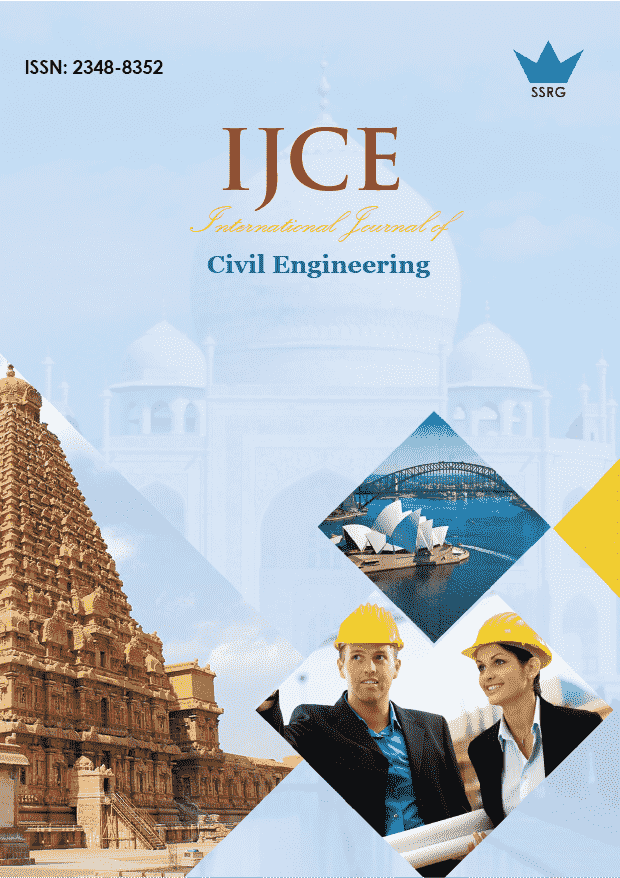Feasibility of Pervious Concrete Pavement: A Case Study of Karanjade Node, Panvel

| International Journal of Civil Engineering |
| © 2019 by SSRG - IJCE Journal |
| Volume 6 Issue 3 |
| Year of Publication : 2019 |
| Authors : Sanika Kandalekar, Raju Narwade, Karthik Nagarajan |
How to Cite?
Sanika Kandalekar, Raju Narwade, Karthik Nagarajan, "Feasibility of Pervious Concrete Pavement: A Case Study of Karanjade Node, Panvel," SSRG International Journal of Civil Engineering, vol. 6, no. 3, pp. 34-39, 2019. Crossref, https://doi.org/10.14445/23488352/IJCE-V6I3P105
Abstract:
The construction industry needs innovative ideas to manage the increasing rate of impervious surfaces. Pervious concrete allows water to pass directly through it, decreases the free runoff, and allows groundwater to recharge. This research study intends to find the feasibility of pervious concrete as a pavement at Karanjade in Panvel, India. Examination of five-year rainfall data helped calculate the quantity of precipitation occurring in this area above 1000mm. Traffic volume study determined low traffic roads during peak hours, which was 378.156 PCU/Hr. Pervious concrete pavement for low traffic volume road was designed as per IRC SP 62: 2014. Slab with a thickness of 200mmwasdesigned and checked for edge and corner stresses.
Keywords:
Pavement Design, PCU, Pervious Concrete, Rainfall Analysis, Traffic Volume Study
References:
[1] Marchioni M. and G. Becciu, Experimental Results On Permeable Pavements In Urban Areas: A Synthetic Review, International Journal of Sustainable Development and Planning., 10 (7),(2015),806–817.
[2] B.Mahesh and B. Lavanya, Experimental Study of Pervious Concrete in Pavements, International Journal of Innovative Research in Science, Engineering and Technology.,5(12) (2016),12913-12924.
[3] Obla and Karthik H, Pervious Concrete for Sustainable Development, Recent Advances in Concrete Technology, (2007).
[4] Sirile Eathakoti, An Innovative No-Fines Concrete Pavement Model, IOSR Journal of Mechanical and Civil Engineering, 12 (5),(2016),34-43.
[5] Parmar Manish and Dr. A. M.Jain, Feasibility of Porous Pavement: A Case Study at Hatkeshwar Area of Ahmedabad City, International Journal of Engineering Development and Research,2(2),(2014),2365-2369.
[6] Miklas Scholz and Piotr Grabowieck, Review of permeable pavement system, Building and Environment Elsevier,42 (2007),3830–3836.
[7] John T. Kevern and Chris Farney, Reducing Curing Requirements for Pervious Concrete with a Superabsorbent Polymer for Internal Curing, Journal of the Transportation Research Board, 2290,(2012),115-12.
[8] C. Lian and Y. Zhuge, Optimum mix design of enhanced pervious concrete – An experimental investigation, Construction, and Building Materials,24(12),(2010),2664–2671.
[9] P. Chindaprasirt, S. Hatanaka, T. Chareerat, N. Mishima, and Y. Yuasa, Cement paste characteristics and porous concrete properties, Construction and Building Materials.,22(5) (2008),894–901.
[10] Ming-Gin Lee, Yi-Shuo Huang, Tao-Kuang Chang, and Chun-HuaPao, Experimental Study of Pervious Concrete Pavement, Emerging Technologies for Material, Design, Rehabilitation, and Inspection of Roadway Pavements Geotechnical Special Publication.,218,(2011),93-99.
[11] M.UmaMaguesvaria,c, and V.L. Narasimhab, Studies on Characterization of Pervious Concrete for Pavement Applications, Procedia - Social and Behavioral Sciences.,(104) (2013),198 – 207.
[12] Darshan S. Shah, Prof. JayeshkumarPitroda and Prof.J.J.Bhavsar, Pervious Concrete: New Era For Rural Road Pavement, International Journal of Engineering Trends and Technology (IJETT)., 4(8),(2013),3495-3499.
[13] Govind Ravish and Er. V.K. Ahuja, No-Fine Concrete as a Road Pavement, International Journal of Engineering Trends and Technology (IJETT).,24 (4), (2015),187-190.
[14] Navin. A.S, Hari Kumar. V, Dheepan, and K.R., Kamal.S, Pervious Pavements: A Miniature Examination International Journal of Engineering Trends and Technology (IJETT), 21(3),(2015),138-143.
[15] Darwin R., Dharmaraj N., and ShahulHameed M., Performance of pervious concrete using marble sludge powder, SSRG International Journal of Civil Engineering- (ICRTCETM), ISSN: 2348-8352,(2017),32-35.
[16] IvanaBarisic, Mario Galic and Ivanka Netinger Grubesa, Pervious concrete mix optimization for sustainable pavement solution, Earth and Environmental Science, IOP Publishing, 90,(2017),1-6.
[17] Udeme J Ndon, Trends in the Application of Permeable Pavement as Sustainable Highway Storm Water Management Option for Safe-Use of Roadways, Journal of Civil & Environmental Engineering, 7, ISSN: 2165-784X, 6(7), 2-15.
[18] Narender Singh, Design aspects of cement concrete pavement for Rural Roads in India, International Journal of Engineering Research and General Science, 3(4),(2015),549-560.
[19] IRC: SP 62, Guidelines for design and construction of cement concrete pavements for low volume road,. (2014).

 10.14445/23488352/IJCE-V6I3P105
10.14445/23488352/IJCE-V6I3P105